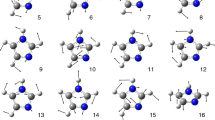Abstract
Room temperature and low temperature Mössbauer and optical absorption spectroscopic data on six natural chloritoids characterized by means of electron microprobe and X-ray powder diffraction techniques are presented.
Two narrow quadrupole doublets with widths of 0.25–0.29 mm/s assigned to Fe2+ in a relatively large octahedral site and Fe3+ in a smaller octahedral site, are observed in the Mössbauer spectra.
Polarized optical absorption spectra reveal three main absorption bands. A broad absorption band at 16,300 cm−1, which is strongly polarized in E‖X and E‖Y and shows a linear increase in integral absorption with increasing [Fe2+] [Fe3+] concentration product, is assigned to a Fe2++Fe3+→Fe3++Fe2+ charge transfer transition. This band displays also a temperature dependence different from that of single ion d−d transitions. Two absorption bands at 10,900 cm−1 and 8,000 cm−1 are, on the basis of compositional dependence and energy, assigned to Fe2+ in the large M(1B) octahedra of the brucite-type layer in chloritoid.
Combined spectroscopic evidence and structural and chemical considerations support a distribution scheme for ferrous and ferric iron which orders the Fe2+ ions in the M(1B) octahedra and the Fe3+ ions in the small M(1A) octahedral sites. Both types of octahedra are found in the brucite type layer of chloritoid.
Similar content being viewed by others
References
Agresti D, Bent M, Persson B (1969) A versatile computer program for analysis of Mössbauer spectra. Nucl Instrum Methods 72:235–236
Amthauer G, Langer K, Schliestedt M (1980) Thermally activated electrom delocalization in deerite. Phys Chem Minerals 6:19–30
Annersten H, Hålenius U (1976) Ion distribution in pink muscovite, a discussion. Am Mineral 61:1045–1050
Bancroft GM (1973) Mössbauer spectroscopy. An introduction for inorganic chemists and geochemists. McGraw-Hill, London
Brindley GW, Harrison FW (1952) The structure of chloritoid. Acta Crystallogr 5:698–699
Faye GH (1972) Relationship between the crystal-field splitting parameter, δVI, and Mhost-O bond distance as an aid in the interpretation of absorption spectra of Fe2+-bearing materials. Can Mineral 11:473–487
Faye GH, Manning PG, Nickel EH (1968) The polarized optical absorption spectra of tourmaline, cordierite, chloritoid and vivianite: ferrous-ferric electronic interaction as a source of pleochroism. Am Mineral 53: 1174–1201
Fransolet A-M (1978) Données nouvelles sur l'ottrélite d'Ottré, Belgique. Bull Minéral 101:548–557
Halferdahl LB (1961) Chloritoid: Its composition, X-ray and optical properties, stability, and occurrence. J Petrol 2:49–135
Hanscom RH (1975) Refinement of the crystal structure of monoclinic chloritoid. Acta Crystallogr Sect B: 31:780–784
Jefferson DA, Thomas JM (1978) High resolution electron microscopy and X-ray studies of non-random disorder in an unusual layered silicate (chloritoid). Proc R Soc London Ser A: 361:399–411
Kramm U (1973) Chloritoid stability in manganese rich low-grade metamorphic rocks, Venn-Stavelot Massif, Ardennes. Contrib Mineral Petrol 41:179–196
Langer K, Frentrup KR (1979) Automated microscope-absorption-spectrophotometry of rock-forming minerals in the range 40,000–5,000 cm−1 (250–2,000 nm). J Microsc Oxford 116:311–320
Manning PG (1968) Absorption spectra of the manganese chain silicates pyroxmangite, rhodonite, bustamite and serandite. Can Mineral 9:348–357
Shannon RD, Prewitt CT (1969) Effective ionic radii in oxides and fluorides. Acta Crystallogr Sect B: 25:925–945
Smith G (1977) Low-temperature optical studies of metal-metal charge transfer transitions in various minerals. Can Mineral 15:500–517
Tricker MJ, Jefferson DA, Thomas JM, Manning PG, Elliott C (1978) Mössbauer and analytical electron microscope studies of an unusual orthosilicate: Chloritoid. J Chem Soc Faraday Trans 2 74:174–181
Author information
Authors and Affiliations
Rights and permissions
About this article
Cite this article
Hålenius, U., Annersten, H. & Langer, K. Spectroscopic studies on natural chloritoids. Phys Chem Minerals 7, 117–123 (1981). https://doi.org/10.1007/BF00308227
Received:
Issue Date:
DOI: https://doi.org/10.1007/BF00308227




